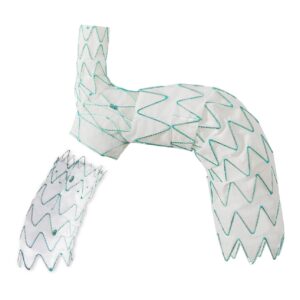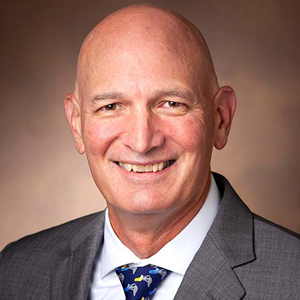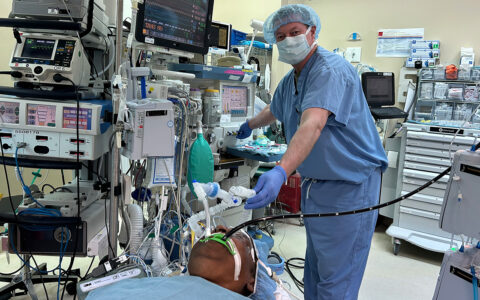An alternative to open surgery for patients with aortic arch disease may soon be on the market.
NEXUS, Endospan’s catheter-based, branched stent graft system undergoing a phase 3 trial, aims to obviate the need for repeat or even first open surgeries in many patients with acute aortic arch aneurysm, refractory aortic dissection, aortic ulcers or intramural hematoma.
Daniel G. Clair, M.D., professor and chair of the Department of Vascular Surgery at Vanderbilt University Medical Center, is site co-primary investigator on the trial, along with Ashish Shah, M.D., professor and chair of the Department of Cardiac Surgery.
“The big benefit is that it avoids the complexity of reoperation.”
“NEXUS is built to address the morphology and hemodynamic challenges of the aortic arch,” Clair said. “The big benefit is that it avoids the complexity of reoperation, which requires circulatory arrest, surgical replacement of the innominate, left common carotid and left subclavian arteries, and replacement of the arch of the aorta.”
Clair and his team completed a trial procedure on a 69-year-old patient in April 2023.
“This patient had had previous surgery for an aortic dissection, but the dissection had extended distally,” Clair said. “There was involvement of his aortic arch, with a segment that was increasing in diameter. A repeat open surgery with a long recovery would have been very difficult for him to undergo.”
Instead, he was given the trial-specified hybrid NEXUS procedure; after a smooth procedure, the patient continues to do well six months later.
Indications and Candidates

Aortic arch disease is associated with bicuspid aortic valve, Marfan syndrome, polycystic kidney disease, atherosclerosis, uncontrolled hypertension, inflammatory disease, family history, and severe heart murmur, along with advanced age, Clair said.
The trial is testing the NEXUS system specifically with patients who have aortic arch aneurysm or a prior open repair of their acute ascending aortic dissection, with residual dissection and aneurysm degeneration through the arch.
The anatomical inclusion criteria are an adequate landing zone in the ascending aorta, the brachiocephalic trunk and the descending thoracic aorta.
The stent graft is designed to minimize the number of sharp angles off the aorta by consolidating flow from three branches to one. Clair noted that acute angles or previous placement of a stent graft in the descending thoracic aorta may present challenges.
Two-day Procedure
Clair performed the first, open stage of the procedure, followed the next day by NEXUS device placement.
On day one, the surgical team made two small incisions at base of the patient’s neck and created a bypass graft from the right carotid to the left carotid artery, and then from the left carotid to the left subclavian artery. After the NEXUS placement, only blood flow from the brachiocephalic trunk continues to perfuse the brain and left arm.
On day two, Clair fed the NEXUS system’s initial stent graft through the femoral artery and up into the brachiocephalic artery.
The fabric-enclosed device is encapsulated in a sheath about the size of the container used in transcatheter aortic valve replacement. Once released, it expands to line and seal the aortic arch, but also blankets the brachiocephalic trunk, maintaining flow to the newly created bypass system. It then extends downward to cloak the descending aorta.
After this component is placed, a second capsule docks to the first and extends into the ascending aorta, completing the lining of the arch of the aorta and the brachiocephalic trunk.
“The expectation is that once the pressure is removed, the aortic wall will shrink and conform to the arterial walls; in dissection cases, that the false lumen will heal around the graft,” Clair said.
Lower Mortality
Clair says stroke hazards in this procedure are equivalent to open sternotomy – between 3 and 5 percent. But risks from injuries caused by cardiopulmonary bypass are reduced. These risks include aorta damage, kidney dysfunction, intestinal or lower extremity ischemia, and central nervous system dysfunction.
An earlier multicenter trial of the NEXUS system examined outcomes in 28 elective patients, with a mean age of 72.2 years. Isolated aortic arch aneurysm was the primary pathology in 17 patients, chronic aortic dissection in six. The remaining five had combined or other pathologies.
Mortality was 7.1 percent, and the combined mortality/stroke rate was 10.7 percent at 30 days. This can be roughly compared against a 10.9 percent in-hospital mortality and a 37.6 percent major morbidity rate in an elective group of 330 open arch replacement patients, which included some emergency cases.
Another, larger, study of patients with elective open aortic dissection surgery found a 13.9 percent overall postoperative mortality rate.
Expanding Options
Once the approved is granted, Clair says the candidate pool for patients is likely to expand.
“I think we’ll see a broad expansion to patients now excluded because they don’t fit the strict the enrollment criteria,” he said, adding that among those are patients with a previous descending thoracic stent graft.
“As more long-term data accumulates, we may see this procedure rise to become a first surgical option for dissections, as well as for aneurysm. Modifications may extend its use to patients with ascending aorta disease and to those needing concurrent aortic valve repair.”
NEXUS Duo, currently CE-mark approved in Europe, is next up for clinical trials in the United States when current trials conclude. The Duo version has a dual branch exit from the aortic arch and can be custom-built based on each patient’s anatomy.
“I hope we will be a study site for this product as well,” Clair said. “Vanderbilt is one of the largest centers in the world for repair of aortic dissection and aortic arch disease, so I imagine we will have a pretty large volume of patients who will have these procedures offered to them as part of the discussion regarding treatment options.”





